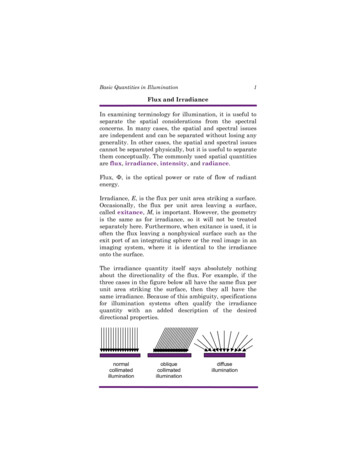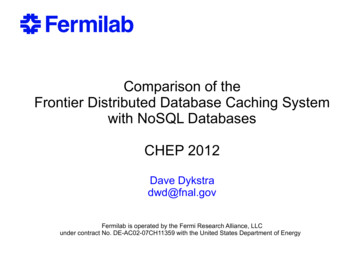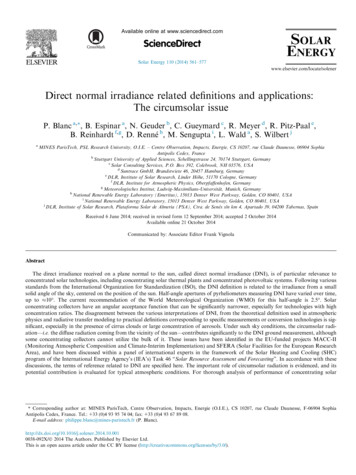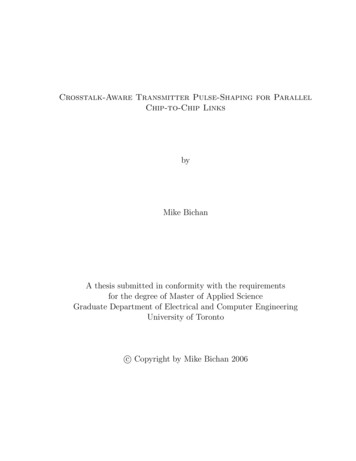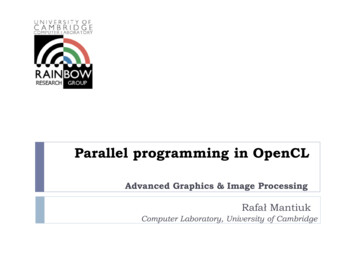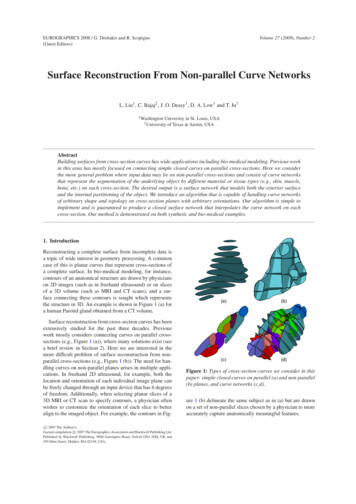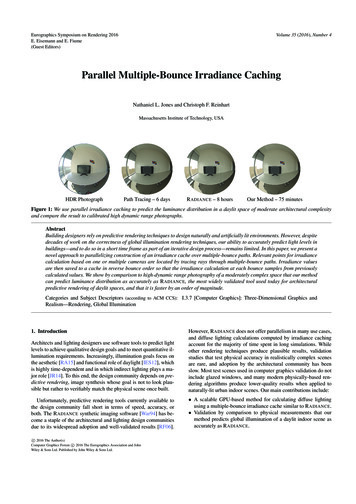
Transcription
Volume 35 (2016), Number 4Eurographics Symposium on Rendering 2016E. Eisemann and E. Fiume(Guest Editors)Parallel Multiple-Bounce Irradiance CachingNathaniel L. Jones and Christoph F. ReinhartMassachusetts Institute of Technology, USAHDR PhotographPath Tracing – 6 daysR ADIANCE – 8 hoursOur Method – 75 minutesFigure 1: We use parallel irradiance caching to predict the luminance distribution in a daylit space of moderate architectural complexityand compare the result to calibrated high dynamic range photographs.AbstractBuilding designers rely on predictive rendering techniques to design naturally and artificially lit environments. However, despitedecades of work on the correctness of global illumination rendering techniques, our ability to accurately predict light levels inbuildings—and to do so in a short time frame as part of an iterative design process—remains limited. In this paper, we present anovel approach to parallelizing construction of an irradiance cache over multiple-bounce paths. Relevant points for irradiancecalculation based on one or multiple cameras are located by tracing rays through multiple-bounce paths. Irradiance valuesare then saved to a cache in reverse bounce order so that the irradiance calculation at each bounce samples from previouslycalculated values. We show by comparison to high-dynamic range photography of a moderately complex space that our methodcan predict luminance distribution as accurately as R ADIANCE, the most widely validated tool used today for architecturalpredictive rendering of daylit spaces, and that it is faster by an order of magnitude.Categories and Subject Descriptors (according to ACM CCS): I.3.7 [Computer Graphics]: Three-Dimensional Graphics andRealism—Rendering, Global Illumination1. IntroductionArchitects and lighting designers use software tools to predict lightlevels to achieve qualitative design goals and to meet quantitative illumination requirements. Increasingly, illumination goals focus onthe aesthetic [RA15] and functional role of daylight [IES12], whichis highly time-dependent and in which indirect lighting plays a major role [JR14]. To this end, the design community depends on predictive rendering, image synthesis whose goal is not to look plausible but rather to verifiably match the physical scene once built.However, R ADIANCE does not offer parallelism in many use cases,and diffuse lighting calculations computed by irradiance cachingaccount for the majority of time spent in long simulations. Whileother rendering techniques produce plausible results, validationstudies that test physical accuracy in realistically complex scenesare rare, and adoption by the architectural community has beenslow. Most test scenes used in computer graphics validation do notinclude glazed windows, and many modern physically-based rendering algorithms produce lower-quality results when applied tonaturally-lit urban indoor scenes. Our main contributions include:Unfortunately, predictive rendering tools currently available tothe design community fall short in terms of speed, accuracy, orboth. The R ADIANCE synthetic imaging software [War94] has become a staple of the architectural and lighting design communitiesdue to its widespread adoption and well-validated results [RF06]. A scalable GPU-based method for calculating diffuse lightingusing a multiple-bounce irradiance cache similar to R ADIANCE. Validation by comparison to physical measurements that ourmethod predicts global illumination of a daylit indoor scene asaccurately as R ADIANCE.c 2016 The Author(s)Computer Graphics Forum c 2016 The Eurographics Association and JohnWiley & Sons Ltd. Published by John Wiley & Sons Ltd.
N. Jones & C. Reinhart / Parallel Multiple-Bounce Irradiance Caching2. Related WorkThe goals of predictive rendering vary substantially from one fieldof application to the next. Virtual prototyping, used for instancein the automotive industry, is concerned with accurate surface reflection properties [UWP06]. Visual psychophysics uses renderedimages to assess human perception of color and shading [RB06].Architects and lighting designers are concerned with producing theappropriate combination of artificial and natural lighting to providea desired appearance for a space while maintaining comfortableand task-appropriate illumination and contrast levels. Increasingly,reducing energy use by increasing access to natural light is also agoal [Rei14]. In this paper, we focus on the field of building performance simulation, which includes the quantitative goals of architects and lighting designers.Building performance simulation puts a unique set of demandson image synthesis tools. Design tools need to produce physicallyaccurate representations and be reasonably fast so as not to interruptthe flow of the user’s thought process [Csi96]. Unfortunately, verifying the accuracy of predictive rendering tools is a messy business,particularly in scenes of typical architectural complexity and under variable daylight conditions. Current lighting guidelines expectsimulated luminance to fall within 20% of actual levels [Rea00],a goal that remains difficult to achieve. To meet design goals, focus is placed on producing correct illuminance levels over broadsurfaces and work planes. This differs from the characteristics thatcontribute to the perception of photorealism because the human eyeis more sensitive to relative luminance and higher spatial frequencies than are typically found in buildings [RWP 95]. Animationis rarely a concern; objects in the scene are static, while the sunposition and sky condition may change [RH00]. The accuracy ofrendering glass is important because glazed windows both modulate incoming light and provide views to external geometry in thescene’s urban context. However, caustic focusing [Nye99] is rarelyencountered because architectural glass tends to have planar geometry. As a result of windows, image synthesis tools must be able towork with a variety of scales, including the detailed geometry of aroom’s interior and the far-away geometry of the urban surroundings which may participate in the diffuse lighting of the scene.2.1. Validation StudiesA renderer produces photorealistic results if it meets three criteria: correct reflection models for surfaces, correct light transportpaths, and physiologically correct display of the results [GTS 97].We are concerned mainly with the first two criteria, as the goal inbuilding performance simulation is to obtain physically accuratelight levels, not to display perceptually convincing images. Validation of the first two criteria is generally done by comparison tophysically measured photometric values. The physical and virtualmodels must have matching geometry, materials, and light sources;however, some inaccuracy is inherent in any model.Early validation studies compared rendered images to photographs [GTGB84,MRC 86,Gry89]. McNamara et al. [MCTG00]used human subjects to compare R ADIANCE and other rendering methods to a photograph and found that while R ADIANCEperformed well, human subjects were not suited to detecting certain physical inaccuracies. A similar comparison by Khodulev andKopylov [KK96] found R ADIANCE to perform best in an analytictest case but lacked a ground truth for image comparison. Dragoand Myszkowski [DM01] used highly accurate material models toapproximate a photograph on a low-dynamic range display, but theysimplified the luminance distribution in the scene by taking photographs at night.Most validation studies rely on point illuminance measurements.When taken in real buildings, reference measurements tend to beheavily influenced by daylight, and thus accurate modeling of thesky is a key concern [PSM93]. R ADIANCE produced the most accurate results in a comparison of four validated rendering packagesto field measurements in one daylit building, although still off byup to 40% [UH98]. Other studies comparing physical daylit building interiors with glazed windows to R ADIANCE predictions foundrelative mean bias error (MBErel ) under 20% and relative root meansquare error (RMSErel ) under 32% [NPWN01, RW01, RA06]. R A DIANCE and 3ds Max [Aut16] gave comparable results in a studyof one building interior under a number of sky conditions [RB09].However, R ADIANCE offered superior results in a repetition of thisstudy at four other geographic locations [BPF15].High dynamic range (HDR) photography can also be used tocapture accurately scaled luminance levels and provides greaterspatial resolution than typical illuminance sensors [Ina06, Ina10,VIJ10, VI14]. Karner and Prantl [KP96] compared photographs ofan artificially lit office to R ADIANCE using gridded regions withMBErel 44%–71% and RMSErel 16.4%–18.5%. When correctedfor image misalignment, the errors were lowered to MBErel 21%–52% and RMSErel 12.9%–17.8%. In cases where photographs andrenderings have poor alignment, average luminance values in manually selected task-zones can also be compared [WC06].2.2. Irradiance CachingDiffuse lighting due to indirect irradiance typically has lowfrequency variation, so a single irradiance calculation may be applied to all ray intersections with similar spatial coordinates and intersected surface normal directions. The irradiance cache is a collection of irradiance values that are saved for reuse, along with theirassociated point locations, normal directions, and validity radii.Ward’s original method implemented in R ADIANCE [WRC88] hasbeen modified by the inclusion of gradients in the calculation ofthe validity radius [WH92] and by the use of second-order gradients (Hessians) to specify an ellipse in which an irradiance value isvalid [JSKJ12, SJJ12].R ADIANCE takes a lazy approach to populating the irradiancecache [WRC88,WH92,SJJ12]. It calculates and saves an irradiancevalue only when no pre-existing value is found for a ray intersection. Those intersections may occur anywhere up to a user-specifiednumber of ray bounces, so we refer to this as a multiple-bounceirradiance cache. Due to the lazy approach, irradiance values calculated at deeper bounces may sample from previously calculatedirradiance values reached through fewer bounces, allowing themin effect to sample diffuse lighting from a greater portion of thescene. As a result, irradiance values calculated through a multiplebounce irradiance cache converge toward an infinite bounce solution more quickly than those calculated from a single-bounce irradiance cache.c 2016 The Author(s)Computer Graphics Forum c 2016 The Eurographics Association and John Wiley & Sons Ltd.
N. Jones & C. Reinhart / Parallel Multiple-Bounce Irradiance CachingAlgorithm 1 Parallel multiple bounce irradiance caching algorithm1: procedure B UILD I RRADIANCE C ACHE2:level 03:points[0] eye4:cache[levelmax ] 5:while level levelmax do6:temp sample geometry seen from points[level]7:Sort temp by cell index8:Increment level9:points[level] rcoarse -spaced points from temp10:end while11:while level 0 do12:Decrement level13:cache[level] sample irradiance from cache[level 1] at points[level 1]14:temp sample geometry seen from points[level]15:Sort temp by cell index16:points[level 1] rmin -spaced points from temp17:cache[level] sample irradiance from cache[level 1] at points[level 1]18:end while19: end procedure2.3. Parallel Irradiance CachingWard’s lazy approach is well-suited to serial implementation. However, R ADIANCE allows multiple processes to write to a singlecache using file locks [LS03]. Improved synchronization methodsuse the Message-Passing Interface (MPI) [KMG99, DSC06] andwait-free synchronization [DDSC09]. Concurrent threads may calculate overlapping and redundant irradiance values, but this happens infrequently so long as the number of threads is small.In massively parallel systems, however, a lazy approach to populating the irradiance cache is likely to produce many redundantentries. The cache can be prefilled with entries that are likely tobe sampled; however, this requires a heuristic approach to determine where irradiance will need to be calculated [PH04]. Various strategies have been proposed to completely prefill the irradiance cache. Splatting [KG09] and pre-convolution [RZD14] provide view-dependent solutions computed in screen space. Neighborclamping [KBPv08], Poisson-disk distribution [LZT 08], microrendering [REG 09], and dithering combined with z-curve clustering [FVKG13] can be used to place calculation points in worldspace, but consider only one diffuse bounce. An adaptive seedingmethod by Wang et al. [WWZ 09] uses quadtrees and k-meansclustering to choose irradiance calculation locations. It also considers only a single bounce within the irradiance cache, but the irradiance values themselves come from photon mapping [ZHWG08].The adaptive seeding algorithm from Wang et al. [WWZ 09]has been extended to cache irradiance at multiple bounces [JR14].Rays are traced outward from a subset of the original point-normalpairs to locate new point-normal pairs for a second bounce irradiance cache. Iteration of this process produces locations for irradiance calculation for the desired number of bounces, with the irradiance values themselves calculated in the reverse order. The userremains responsible for predicting the necessary size of the irradiance cache, which is impractical in most real cases and prohibitswidespread adoption of the method. Unfortunately, poor cache sizc 2016 The Author(s)Computer Graphics Forum c 2016 The Eurographics Association and John Wiley & Sons Ltd. parallel coarse geometry sampling. parallel coarse irradiance sampling. parallel fine geometry sampling. parallel fine irradiance samplinging lead either to under- or over-coverage of the scene, which ineither case can severely increase rendering times. Our method issimilar in approach but automatically creates an irradiance cachethat gives full scene coverage with near-optimal size.3. MethodOur method allows any existing
other rendering techniques produce plausible results, validation studies that test physical accuracy in realistically complex scenes are rare, and adoption by the architectural community has been slow. Most test scenes used in computer graphics validation do not include glazed windows, and many modern physically-based ren-
